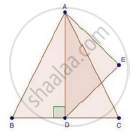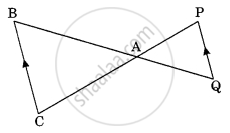Advertisements
Advertisements
प्रश्न
AD is an altitude of an equilateral triangle ABC. On AD as base, another equilateral triangle ADE is constructed. Prove that Area (ΔADE): Area (ΔABC) = 3: 4
उत्तर

We have,
ΔABC is an equilateral triangle
Then, AB = BC = AC
Let, AB = BC = AC = 2x
Since, AD ⊥ BC then BD = DC = x
In ΔADB, by Pythagoras theorem
𝐴𝐵2 = (2𝑥)2 − (𝑥)2
⇒ 𝐴𝐷2 = 4𝑥2 − 𝑥2 = 3𝑥2
⇒ 𝐴𝐷 = `sqrt3`𝑥 cm
Since, ΔABC and ΔADE both are equilateral triangles then they are equiangular
∴ ΔABC ~ ΔADE [By AA similarity]
By area of similar triangle theorem
`("area"(triangleADE))/("area"(triangleABC))="AD"^2/"AB"^2`
`=(sqrt3x)^2/(2x)^2`
`=(3x^2)/(4x^2)`
`=3/4`
APPEARS IN
संबंधित प्रश्न
Diagonals of a trapezium ABCD with AB || DC intersect each other at the point O. If AB = 2CD, find the ratio of the areas of triangles AOB and COD.
ABC is a triangle in which ∠A =90°, AN⊥ BC, BC = 12 cm and AC = 5cm. Find the ratio of the areas of ΔANC and ΔABC.
In ABC, P divides the side AB such that AP : PB = 1 : 2. Q is a point in AC such that PQ || BC. Find the ratio of the areas of ΔAPQ and trapezium BPQC.
If ΔABC and ΔBDE are equilateral triangles, where D is the mid-point of BC, find the ratio of areas of ΔABC and ΔBDE.
Prove that the points (2, −2), (−2, 1) and (5, 2) are the vertices of a right angled triangle. Also find the area of this triangleb ?
Prove that in a right-angle triangle, the square of the hypotenuse is equal to the sum of squares of the other two sides.
Prove that in a right triangle, the square of the hypotenuse is equal to the sum of the squares of the other two sides.
In the given figure, ΔACB ~ ΔAPQ. If AB = 6 cm, BC = 8 cm, and PQ = 4 cm then AQ is equal to ______.

If ΔABC ~ ΔPQR, AB : PQ = 4 : 5 and A(ΔPQR) = 125 cm2, then find A(ΔABC).
If the perimeter of two similar triangles is in the ratio 2 : 3, what is the ratio of their sides?
